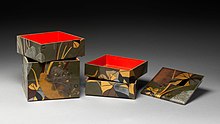Jūbako
Japanese food box

Jūbako (重箱, lit. "tiered boxes") are tiered boxes used to hold and present food in Japan.[1] The boxes are often used to hold osechi, foods traditional to the Japanese New Year,[2] or to hold takeaway lunches, or bento.
A sagejū (提重, lit. "portable jūbako") or sagejūbako (提げ重箱), is a picnic set of jūbako in a carrier with handle.[3]
There is also jikirō (食籠, lit. "food basket"), a kind of chinese styled bowl,[4] some stackable like jūbako.[5]
Gallery
-
 An 18th century wood, gold and silver foil jūbako
An 18th century wood, gold and silver foil jūbako -
 Sagejū
Sagejū -
 Jikirō
Jikirō
See also
- Tiffin carrier: tiered lunchbox of India and the Caribbean
References
- ^ "Food and Dishware as Landscapes". Highlighting Japan. Public Relations Office of the Government of Japan. 2021-01-02. Archived from the original on 2021-01-20. Retrieved 2021-08-11.
- ^ "Osechi-ryori: The New Year's Feast". Consulate General of Japan in New York. 2020-11-26 [2016]. Archived from the original on 2017-07-14. Retrieved 2021-08-11.
- ^ "Portable Picnic Set (sagejū) with Chrysanthemums, Foliage Scroll, and Tokugawa Family Crest 18th century". Metropolitan Museum of Art.
- ^ "The Lacquer Artisan Sano Chokan". Kyoto National Museum. Archived from the original on 2018-08-24. Retrieved 2021-08-11.
- ^ Lawrence, Trevor (1895). Huish, Marcus B. (ed.). Catalogue of the collection of Japanese works of art : formed between the years 1869 and 1894. (privetely printed). p89: item 1186; p82: item 1186. hdl:2027/yale.39002044802859.
External links
Jūbako at Wikipedia's sister projects
 Definitions from Wiktionary
Definitions from Wiktionary Media from Commons
Media from Commons Data from Wikidata
Data from Wikidata
- v
- t
- e
Japanese food and drink
- Bento
- Ekiben
- Jūbako
- Kyaraben
- Makunouchi
- Wappameshi
- Chahan
- Curry
- Katsu curry
- Donburi
- Chūkadon
- Katsudon
- Oyakodon
- Tekkadon
- Tenshindon
- Unadon
- Gyōza
- Gyūdon
- Hayashi rice
- Hirayachi
- Hiyamugi
- Kaki furai
- Kakuni
- Karaage
- Kushikatsu
- Monjayaki
- Nabemono
- Nikujaga
- Noodles
- Oden
- Okonomiyaki
- Okowa
- Omurice
- Onigiri
- Onsen tamago
- Osechi
- Rice
- Sashimi
- Shabu-shabu
- Soki
- Sukiyaki
- Sushi
- Takoyaki
- Tamagoyaki
- Tempura
- Tokoroten
- Tonkatsu
- Tsukudani
- Tsukune
- Yakiniku
- Yakitori
- Agedashi dōfu
- Bread
- Chawanmushi
- Gari
- Korokke
- Miso soup
- Namasu
- Nattō
- Nukazuke
- Okazu
- Satsuma-age
- Shiokara
- Takuan
- Tororo
- Tsukemono
desserts
condiments
 Category
Category


















